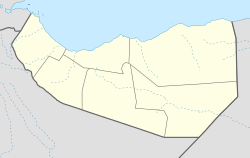Togo Wuchale | |
|---|---|
City | |
| Coordinates: 9°36′05″N43°20′10″E / 9.60139°N 43.33611°E | |
| Country | |
| Region | Somali region |
| Population | |
• Total | 50,450 |
| Time zone | UTC+3 (EAT) |
Tog Wuchale (also known as Wajaale) is a city located in Eastern Ethiopia on the border of Ethiopia and Somaliland. Tog Wajaale is the main border crossing for goods coming in and out of Ethiopia, primarily from the port city of Berbera, Somaliland's main port. [1] It is one of the busiest border towns of Ethiopia. The city is exclusively inhabited by people from the Somali ethnic group, with the Jibril Abokor sub-divisions of the Sa'ad Musa subclan of the Habar Awal Isaaq, dominating both the town itself and the wider Wajaale district. [2] [3]

